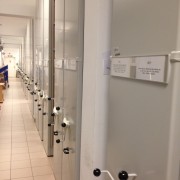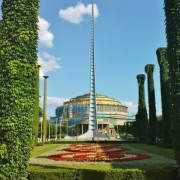Leaving Space for Memory
By: Jake “Andy” Fabrizio
Historical injustices do not go unnoticed. The truth, no matter how suppressed or malformed, will eventually come out. Proper commemoration, however, does not lie necessarily within the very presence of truth but within the acts of acknowledging and effectively disseminating the truth. The first step is acknowledgement because if the past is not recognized as true it cannot be properly commemorated.
In analyzing the commemoration of historical injustices, I think of three distinct categorizations embodied in sites from our field studies: the city of Krynki, the Monument of Shared Memory in Wrocław, and the Auschwitz-Birkeneau camps.
The first category is when the past is not officially acknowledged at all, consequently leaving no space for memory. In Krynki, the city’s multicultural past is almost entirely unknown, if not completely and purposefully ignored. Initiative is taken by a few locals to share the dynamic past where Poles, Jews, and Byelorussians flourished and lived side-by-side, mostly harmoniously, but the agenda of the city and the majority of its residents is that of an all-Polish heritage with no room for minorities. Excepting special interest groups, such as our study cohort, no one in the community seems to know of the liquidation of the Jews and of their rich heritage in Krynki, and discrimination against non-Poles seems to be the norm. Empty spaces echo with the past, but no one seems to care. While individuals attempt to commemorate the city’s rich history, the truth is not acknowledged therefore there is no collective memory.
The Monument of Shared Memory in Wrocław falls in to the second category of historical memory. Here, the past is acknowledged but not disseminated in an effective fashion. The monument is on the site of a razed German cemetery, which now functions primarily as a park, and secondarily as a site of reflection and memory. Prior to the end of the Second World War, Wrocław was the German city of Breslau. Municipality officials admit to the act of and their negligence in recognizing the act of ethnic cleansing and the defacement of burial grounds, and they create a monument to memorialize the event and the people affected. To say the least, the monument is insufficient, and it seems to have been created by the municipality in effort to check “commemoration” of their agenda. It almost seems like it has the converse effect. Rather than creating discussion, it seems as if the city created the monument to stop people from saying that it did not do anything. It was an entirely political move with no thought of the greater meaning behind it. The monument itself is vague and, for the common person who happens upon it, tells nothing of what its purpose is and certainly does not share any type of historical truth. And that is if a person stumbles upon it- until recently the monument was set deep in the back of the park and bushes and shrubs shrouded the entrance. It has recently been opened- for logistical reasons of the municipality’s tram system- but hopefully this logistical need will have the unintentional effect of bringing people to the site of memory and sparking dialogue.
I regard the third category as proper commemoration. In this category, actual history is acknowledged objectively and is presented meaningfully without attempting to end discussion on the matter at hand. In my opinion, the Auschwitz-Birkeneau camp complex effectively transmits history while at the same time allowing space for reflection and remembrance. The camps do not tell youhow to remember, but they provide you with adequate knowledge to do so. The truth is not hidden, instead it is right in front of you. The camps have been left in tact, so, unlike the Monument of Shared Memory, the form is not ambiguous. Rather it is meaningful and straightforward. The focus at places of memory such as Auschwitz is not per se the historical events in isolation, but instead is the dissemination of facts and acknowledgment that injustice did take place in an effort to promote remembrance and to prevent such atrocities from happening again. It does not feel quite right to say that Auschwitz is at peace with its past for I do not think the horrors of the Holocaust can ever be fully reconciled with, but I will suffice to say that, in its capacity as a site of memory, the camp and its horrid past are presented in a fashion that appropriately and meaningfully leaves room for memory, on both official and individual levels.








